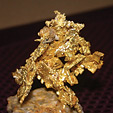Prospecting & Detecting
Making Adjustments to Catch Fine Gold
November 2013 by Alex Dolbeare
This fine gold that is so common is probably the most notorious for eluding our riffles and mattings.Memories of Shirttail Creek, Northern California
 …for a few hours, we fervently dug for gold. After we did a cleanup, I couldn’t believe the amount we got.
…for a few hours, we fervently dug for gold. After we did a cleanup, I couldn’t believe the amount we got.
Dredging Safety: Don't Ignore The Warning Signs
 At first, I tried to shift things around, but then a hand with a rock would appear, so I would stop trying to adjust my gear and grab the rock to keep things moving.
At first, I tried to shift things around, but then a hand with a rock would appear, so I would stop trying to adjust my gear and grab the rock to keep things moving.
Carr Fire Gold
 After burning more than 350 square miles, the Carr Fire near Redding, California, was finally out. Luckily our home was spared, and I had the opportunity to go metal detecting in burned areas previously too overgrown to access.
After burning more than 350 square miles, the Carr Fire near Redding, California, was finally out. Luckily our home was spared, and I had the opportunity to go metal detecting in burned areas previously too overgrown to access.
The Forms of Crystalline Gold
 The largest and most perfect single gold crystals are nearly always in the form of octahedra. These large octahedral crystals often possess deeply recessed faces.
The largest and most perfect single gold crystals are nearly always in the form of octahedra. These large octahedral crystals often possess deeply recessed faces.
Detecting Strategies for Heavily Forested Areas—Part II
 Patience and persistence is the name of the game when you are detecting this way for gold, as you will have to do a lot of work preparing the ground to detect with any degree of success.
Patience and persistence is the name of the game when you are detecting this way for gold, as you will have to do a lot of work preparing the ground to detect with any degree of success.
Swing and a Miss
 A very good baseball hitter might get a hit roughly one time out of every three at-bats, but for prospectors often the results are much sparser and it may take many trips before the prospector hits a home run.
A very good baseball hitter might get a hit roughly one time out of every three at-bats, but for prospectors often the results are much sparser and it may take many trips before the prospector hits a home run.
Subscription Required:
The Bawl Mill
• Ask the Experts
• One Potato, Two Potato...
• Proper Placer Sample Processing
• Strategic Metals—Part I
• Dry Washing to Capture Fine Gold
• Are There Any Good Prospects Left?
• Ophir—Possibly the Best Kept Secret in Alaska!
• Southern Oregon's Illinois River—A Lesson in Sharing
• Using Sucker Guns to Find Gold
• The Subsurface Suction Dredge
• A Few Thoughts About Successful Nugget Hunting
• Melman on Gold & Silver
• Mining Stock Quotes and Mineral & Metal Prices








